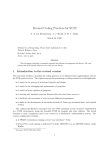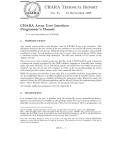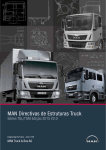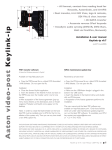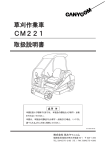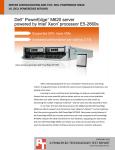Download Dell MD3000i How to Use
Transcript
book.book Page 1 Monday, April 19, 2010 5:06 PM Dell™ PowerEdge™ Cluster Systems Using Dell Blade Servers in a Dell PowerEdge High Availability Cluster book.book Page 2 Monday, April 19, 2010 5:06 PM Notes and Cautions NOTE: A NOTE indicates important information that helps you make better use of your computer. CAUTION: A CAUTION indicates potential damage to hardware or loss of data if instructions are not followed. ____________________ Information in this document is subject to change without notice. © 2007–2010 Dell Inc. All rights reserved. Reproduction of these materials in any manner whatsoever without the written permission of Dell Inc. is strictly forbidden. Trademarks used in this text: Dell, the DELL logo, PowerEdge, PowerVault, EqualLogic, and OpenManage are trademarks of Dell Inc.; EMC is the registered trademark of EMC Corporation; Microsoft, Windows, and Windows Server are either trademarks or registered trademarks of Microsoft Corporation in the United States and/or other countries. Other trademarks and trade names may be used in this document to refer to either the entities claiming the marks and names or their products. Dell Inc. disclaims any proprietary interest in trademarks and trade names other than its own. April 2010 Rev. A01 book.book Page 3 Monday, April 19, 2010 5:06 PM Contents 1 Introduction . Overview . . . . . . . . . . . . . . . . . . . . . . . . 5 . . . . . . . . . . . . . . . . . . . . . . . . . 5 Supported PowerEdge Blade Server Cluster Components . . . . . . . . . PowerEdge Server Enclosure 6 16 16 . . . . . . . . . . . . . 17 . . . . . . . . . . . . . . 20 . . . . . . . . . . . . . . . . . . . 21 Blade Server Requirements . Cluster Storage . . . . . . . . . . . . . . . . . . . Other Documents You May Need 2 . . . . . . . . . . . . . . . . . . . . . . . Switch-Attached Cluster . Cluster Nodes . 6 . . . . . . . . . . . . . . Supported Cluster Configurations . Direct-Attached Cluster . . . . . . . . . . . . . . . . . . . . . . . Cabling Your Blade Cluster Hardware . . . . . . . . . . . . . . . . . . . . . . . . Cabling Your Cluster For Public and Private Networks . . . . . . . . . . 22 23 25 . . . . . . . . . . 25 Cabling the Private Network . . . . . . . . . . . . 27 Cabling the Public Network . . . . . . . . . . . . 28 Cabling the Storage Systems . . . . . . . . . . . . . . 29 Direct-Attached Cluster . . . . . . . . . . . . . . 29 Network-Attached Cluster . . . . . . . . . . . . . Contents 32 3 book.book Page 4 Monday, April 19, 2010 5:06 PM Installing the Operating System and Configuring Your Cluster . . . . . . . Maintaining Your Cluster 4 Contents . . . . . . . . . . 47 . . . . . . . . . . . . . . . . 47 book.book Page 5 Monday, April 19, 2010 5:06 PM 1 Introduction This document provides information for installing and managing your Dell™ PowerEdge™ blade server in a Dell PowerEdge cluster system and specific information about clustering your PowerEdge blade server modules with supported Dell PowerVault™, Dell EqualLogic™, and Dell/EMC storage systems. Use this document in conjunction with the Installation and Troubleshooting Guide for your supported Dell PowerEdge cluster solution. This document is intended for experienced IT professionals who need to configure the cluster solution, and for trained service technicians who perform upgrade and maintenance procedures. Overview Clustering uses specific hardware and software to join multiple systems together to function as a single system and provide an automatic failover solution. If one of the cluster nodes (also referred to as nodes) fails, resources running on the failed system are moved (or failed over) to one or more systems in the cluster either by Microsoft® Windows Server® 2003 Cluster Server (MSCS), Windows Server 2008 Failover Clustering, or Windows Server 2008 R2 Failover Clustering software. Cluster nodes share access to external storage systems; however, only one of the nodes can own any virtual disk or Logical Unit Number (LUN) in the external storage system at any time. The cluster software controls which node has access to each virtual disk in the shared storage system. NOTE: Throughout this document, MSCS refers to either Microsoft Cluster Server or Microsoft Failover Clustering. When the failed system is repaired and brought back online, resources automatically transfer back (or fail back) to the repaired system or remain on the failover system, depending on how MSCS is configured. For more information about MSCS, see the Installation and Troubleshooting Guide. Introduction 5 book.book Page 6 Monday, April 19, 2010 5:06 PM Supported PowerEdge Blade Server Cluster Components The following sections discuss the various cluster components that are supported with your PowerEdge blade server cluster configuration. PowerEdge Server Enclosure The Dell PowerEdge cluster solution supports the Dell PowerEdge blade server enclosures. These systems function as enclosures for multiple PowerEdge server modules that can be configured together into multiple clusters. The system is configured with internal connections and hotpluggable hardware components that provide the necessary communication links between the individual server modules (private network), the client network (public network), and an additional PowerEdge server enclosure. Multiple PowerEdge server enclosures can be connected together in a cluster configuration. For supported cluster configurations, see "Cabling Your Blade Cluster Hardware" on page 25. 6 Introduction book.book Page 7 Monday, April 19, 2010 5:06 PM Figure 1-1 provides a front and back view of the PowerEdge 1855/1955 system. Figure 1-2 provides a front and back view of the PowerEdge M1000e system. Figure 1-1. PowerEdge 1855/1955 Server Enclosure Overview 1 2 front view 13 3 12 4 5 11 10 4 3 6 9 8 1 2 7 back view Introduction 7 book.book Page 8 Monday, April 19, 2010 5:06 PM 8 1 server module (10) 8 power supply module (4) 2 front-panel indicators 9 blanks (2) 3 Ethernet switch module or Ethernet 10 pass-through module (not shown) (2) Ethernet switch module (2) or Ethernet pass-through module (not shown) (2) 4 I/O bay 1 11 I/O bay 4 5 I/O bay 3 12 I/O bay 2 6 KVM module 13 fan modules (2) 7 DRAC/MC or CMC module Introduction book.book Page 9 Monday, April 19, 2010 5:06 PM Figure 1-2. PowerEdge M1000e Server Enclosure Overview 1 2 3 front view A1 B1 C1 B2 C2 17 17 18 18 19 19 20 20 21 21 22 22 23 23 0 0 4 A2 5 6 7 13 12 11 back view 10 9 8 Introduction 9 book.book Page 10 Monday, April 19, 2010 5:06 PM 1 server module 8 I/O bay A2 2 power switch and KVM ports 9 I/O bay B2 3 control panel 10 I/O bay C2 4 DRAC/MC or CMC module 11 I/O bay C1 5 KVM module 12 I/O bay B1 6 fan module 13 I/O bay A1 7 power supply module The power supply modules, fan modules, Dell Remote Access Controller/Modular Chassis or Chassis Management Enclosure (DRAC/MC or CMC), and I/O modules are shared resources of the server modules in the chassis. The system may ship with an optional external Universal Serial Bus (USB) diskette drive and an optional external USB CD drive, which you can use to set up and configure the server modules. For information on supported cluster configurations, see "Cabling Your Blade Cluster Hardware" on page 25. For a list of supported hardware and software components, see the Support Matrix at dell.com. NOTE: To ensure proper operation and cooling, all bays must be populated with either a server module or a blank prior to turning on the system. The PowerEdge server enclosure includes the following hardware components for a cluster configuration: • Server modules • Ethernet switch modules or Ethernet pass-through modules (based on your configuration) NOTE: Throughout this document, Ethernet switch modules refer to either Gigabit or 10 Gigabit Ethernet switch modules and Ethernet pass-through modules refer to either Gigabit or 10 Gigabit Ethernet pass-through modules. 10 • Fibre Channel switch modules or Fibre Channel pass-through modules (based on your configuration) • DRAC/MC or CMC Introduction book.book Page 11 Monday, April 19, 2010 5:06 PM Dell Remote Access Controller/Modular Chassis or Chassis Management Enclosure The Dell Remote Access Controller/Modular Chassis or Chassis Management Enclosure (DRAC/MC or CMC) is a management module located in the back of the blade server system chassis that provides all of the chassis management functionality. The DRAC/MC or CMC provides serial and out-of-band Ethernet management ports to allow for management of the chassis and some basic blade functions. The following is a list of features available on the DRAC/MC or CMC. Your system may have updates that enable additional features. Refer to the latest Dell Remote Access Controller/Modular Chassis User’s Guide or Chassis Management Controller User’s Guide at support.dell.com. • Remote management and monitoring of a system through the DRAC/MC web-based graphical user interface (GUI), serial connection, or telnet connection. • Access to the chassis System Event Log (SEL) and DRAC/MC or CMC logs. • Integrated launch of the DRAC/MC or CMC interface from the Dell OpenManage™ IT Assistant. • Ability to alert you to potential problems on the DRAC/MC or CMC by sending either an e-mail message or an SNMP trap through the DRAC/MC or CMC NIC to a management station. • Ability to configure the DRAC/MC or CMC and update DRAC/MC or CMC firmware using a telnet session, a web-based user interface, or through a terminal session (for example, a hyperterminal or similar program). • Ability to manage controller configurations, I/O modules configurations and settings, and perform power management functions such as shutdown, power up, and reset, from a telnet session. • Web-based interface password-level security management. • Role-based authority that provides assignable permissions for different systems management tasks. Introduction 11 book.book Page 12 Monday, April 19, 2010 5:06 PM Server Modules Depending on the PowerEdge blade server module you choose for your cluster, the number of available expansion ports and dual inline memory modules (DIMMs) varies. Table 1-1 provides details about the supported PowerEdge server modules and PowerEdge server enclosures. Table 1-1. PowerEdge Blade Server Features Server Enclosure 1855/1955 M1000e Supported blade server modules PowerEdge 1855, 1955 See the Support Matrix at dell.com/ha for information on supported blade server types. Maximum number of server 10 modules per server enclosure 16 Number of mezzanine card slots per server module 2 1 In a Dell PowerEdge high availability cluster configuration, each server module requires at least one expansion card. Expansion cards for either Fibre Channel or Ethernet (for iSCSI) are available, and allow the server module to communicate with the shared storage system for the cluster. The expansion cards, also known as daughter cards or mezzanine cards, are installed on the server module and contain two I/O ports. These I/O ports are internally connected to two separate I/O modules in the server enclosure. By attaching to two separate I/O modules, an expansion card can provide redundant paths and load balance the I/O from the server module to the shared storage system(s) for the PowerEdge cluster solution. Table 1-1 outlines the number of expansion cards that are available on each supported server module. Each server module is also configured with two additional Ethernet ports for cluster interconnects. These are internally connected to two separate Ethernet pass-through or Ethernet switch modules in the server enclosure. With certain server modules, it is also possible to configure additional Ethernet ports, which can enable the use of NIC teaming on the cluster public network. 12 Introduction book.book Page 13 Monday, April 19, 2010 5:06 PM Gigabit or 10 Gigabit Ethernet The following are the Ethernet network connections available, depending on your configuration: • Public connection from the server modules to the public network • Private node-to-node connection between the server modules for the private network • iSCSI connection between the server modules and storage system(s). For more information, see "Supported Cluster Configurations" on page 16. The server modules include two integrated Ethernet network interface cards (NICs). You must configure at least two networks for each PowerEdge cluster solution. One cluster network is configured for heartbeat communications (private network) and is only accessible to the server modules in the cluster. The other cluster network is configured for the client network (public network) and is accessible to client systems. It is recommended that you configure the same network interface on each node for the same role in the cluster. For example, you can use the two integrated NICs to provide the private and public cluster networks. Such a configuration allows an expansion card in the server module to provide the I/O interface for the shared storage system(s) in the cluster. Use an Ethernet expansion card for iSCSI shared storage systems and use a Fibre Channel expansion card for Fibre Channel shared storage systems. For more information about iSCSI and Fibre Channel clusters, see "Supported Cluster Configurations" on page 16. Ethernet Switch Module The Ethernet switch module provides a switched connection to the integrated NICs on each server module. Using the internal connections in the system chassis, the Ethernet switch module can be used to provide the following configurations: • A switched connection to the client network (public network). • Network connection to one or more server modules in the Cluster configuration (private network). • iSCSI connection between the server modules and storage system(s). For more information, see "Supported Cluster Configurations" on page 16. Introduction 13 book.book Page 14 Monday, April 19, 2010 5:06 PM Ethernet Pass-Through Module The Ethernet pass-through module provides a non-switched connection between the server modules and an external Ethernet device. Table 1-2 summarizes the supported Ethernet module configurations. Table 1-2. Supported Ethernet Module Configurations Ethernet Switch Module for iSCSI Ethernet Pass-Through Module for iSCSI Switch-attached configuration to Direct-attached configuration to a four supported Dell/EMC or Dell/EMC or PowerVault iSCSI storage PowerVault iSCSI storage systems or system one PS Series group Switch-attached configuration to an external iSCSI network with up to four supported Dell/EMC or PowerVault iSCSI storage systems or one PS Series group Switch-attached configuration to an external iSCSI network with up to four supported Dell/EMC or PowerVault iSCSI storage systems or one PS Series group The following are the supported cable types for Gigabit Ethernet: • Optical cables with LC connectors • CAT5e cables with RJ45 connectors • CAT6 cables with RJ45 connectors The following are the supported cable types for 10 Gigabit Ethernet: • Optical cables with LC connectors • CAT6 cable with RJ45 connectors • SFP+ Direct Attached cables NOTE: For information about supported cable types to connect the blade chassis to an external switch or storage system, see the switch documentation. Fibre Channel Module You can configure the PowerEdge blade cluster with two hot-pluggable Fibre Channel switch modules installed on a PowerEdge 1855/1955 system or up to four hot-pluggable Fibre Channel switch/pass-through modules installed on the PowerEdge M1000e system to provide Fibre Channel connection between the server modules and storage system(s). 14 Introduction book.book Page 15 Monday, April 19, 2010 5:06 PM For more information about the Fibre Channel modules, see your Dell PowerEdge system documentation. Fibre Channel Switch Module The Fibre Channel switch module provides a switched connection between the Fibre Channel daughter card in the server modules and a supported Fibre Channel device. The switch module functions as a director, mapping requests and responses between the interconnected devices. Additionally, the Fibre Channel switch module includes an internal serial port that communicates with the DRAC/MC or CMC module. The Fibre Channel switch module supports the following configurations: • Switch-attached configuration with up to two supported Dell/EMC storage systems • Switch-attached connection to an external storage area network (SAN) with up to four supported Dell/EMC storage systems Fibre Channel Pass-Through Module The Fibre Channel pass-through module provides a direct connection between the Fibre Channel daughter card in the server modules and a supported Fibre Channel device. The pass-through module functions as a dedicated link between the server modules and specific ports on the pass-through module. The pass-through module supports the following configurations: • Direct-attached configuration to a supported Dell/EMC storage system • Switch-attached connection to an external SAN with up to four supported Dell/EMC storage systems Table 1-3 summarizes the supported Fibre Channel module configurations. Introduction 15 book.book Page 16 Monday, April 19, 2010 5:06 PM Table 1-3. Supported Fibre Channel Module Configurations Fibre Channel Switch Module Fibre Channel Pass-through Module Network-attached configuration to one or Direct-attached configuration to a two supported Dell/EMC Fibre Channel Dell/EMC Fibre Channel storage system storage systems using embedded Fibre Channel switch modules Switch-attached configuration to an Switch-attached connection to an external SAN with up to four supported external SAN with up to four supported Dell/EMC Fibre Channel storage systems Dell/EMC Fibre Channel storage systems Supported Cluster Configurations The PowerEdge blade servers support both Fibre Channel and iSCSI cluster configurations using either Fibre Channel mezzanine cards or Ethernet mezzanine cards to connect to the corresponding shared storage system in either direct-attached or switch-attached environments. Direct-Attached Cluster In a direct-attached cluster, the cluster nodes are directly attached to a single storage system. The HBAs (mezzanine cards/daughter cards) in the nodes are internally connected to the pass-through modules. The pass-through modules are connected by cables directly to the RAID controllers (or storage processors) on the storage system. Figure 1-3 shows the logical components of a direct-attached cluster configuration. 16 Introduction book.book Page 17 Monday, April 19, 2010 5:06 PM Figure 1-3. Direct-Attached Cluster public network private network cluster node cluster node chassis connections pass-through module storage system Switch-Attached Cluster Switch -attached clusters provide configuration flexibility, expandability, and performance. In a switch-attached cluster, all of the nodes (server modules) are attached to redundant switch fabrics. A switch-attached cluster supports the following configurations: • Up to two storage systems using embedded fibre channel switch modules without external fibre channel switches • Up to four storage systems using Ethernet switch modules, or embedded fibre channel (switch or pass-through) modules connected to external fibre channel switches Figure 1-4 shows the switch-attached cluster connected to an external SAN using switch modules. Figure 1-5 shows the switch-attached cluster connected to an external SAN using embedded pass-through modules. Figure 1-6 shows the switch-attached cluster connected to an external SAN using embedded switch modules. NOTE: Figure 1-4 through Figure 1-6 are for illustration only. Some cluster connections shown below are routed internally through the PowerEdge server enclosure. Introduction 17 book.book Page 18 Monday, April 19, 2010 5:06 PM Figure 1-4. Switch-Attached Cluster Connected to an External SAN Using Embedded Switch Modules public network cluster node private network embedded switch module embedded switch module storage system 18 Introduction cluster node book.book Page 19 Monday, April 19, 2010 5:06 PM Figure 1-5. Switch-Attached Cluster Connected to an External SAN Using Embedded Pass-Through Modules public network cluster node private network cluster node embedded passthrough module embedded passthrough module external switch external switch storage system Introduction 19 book.book Page 20 Monday, April 19, 2010 5:06 PM Figure 1-6. Switch-Attached Cluster Connected to an External SAN Using Embedded Switch Modules public network cluster node embedded switch module private network inter-switch link inter-switch link external switch cluster node embedded switch module external switch storage system NOTE: It is recommended that you configure the paired inter-switch links (ISLs) as shown in Figure 1-6 for clusters with Fibre Channel storage systems. In an iSCSI cluster configuration, multiple connections between internal switch modules and external switches may not be practical depending on the Ethernet switch features. Blade Server Requirements Your cluster requires the following components: 20 • Server modules (cluster nodes) • Fibre Channel or iSCSI storage subsystem interconnects • Cluster interconnects (private network) • Client network connections (public network) • Operating system and storage management software Introduction book.book Page 21 Monday, April 19, 2010 5:06 PM Cluster Nodes Table 1-4 lists the hardware requirements for the server modules in the PowerEdge server enclosure. Table 1-4. Cluster Node Requirements Component Minimum Requirement Cluster nodes Two to eight PowerEdge server modules running: • Microsoft® Windows Server® 2003 Enterprise Edition • Windows Server 2003 R2 Enterprise Edition • Windows Server 2003 Enterprise x64 Edition • Windows Server 2003 R2 Enterprise x64 Edition Two to sixteen PowerEdge server modules running: • Windows Server 2008 Enterprise x64 Edition • Windows Server 2008 R2 Enterprise x64 Edition RAM At least 512 MB of RAM installed per server module Fibre Channel mezzanine card If the cluster is configured with a Fibre Channel shared storage system, at least one dual-port Fibre Channel mezzanine card per server module iSCSI mezzanine card If the cluster is configured with an iSCSI shared storage system, at least one Ethernet mezzanine card per server module Network Interface Cards (NICs) At least two Ethernet interfaces per server module RAID controller (optional) One controller connected to two internal hard drives for each server module in a RAID 1 configuration NOTE: It is strongly recommended that you use hardware-based RAID or software-based disk-fault tolerance for the internal drives. Introduction 21 book.book Page 22 Monday, April 19, 2010 5:06 PM Cluster Storage Table 1-5 lists supported storage systems and the configuration requirements for the cluster nodes and stand-alone systems connected to the storage systems. Table 1-5. Cluster Storage Requirements Storage Configuration Requirement Supported storage See the Dell Cluster Configuration Support Matrix at dell.com/ha. Cluster shared storage If you are using either switch modules or pass-through modules to connect to network storage devices that are attached to external switches in a SAN or an IP SAN, see the Dell Cluster Configuration Support Matrix at dell.com/ha to determine the maximum number of supported storage systems. If you are using fibre channel modules to connect to storage devices without external fibre channel switches, you can use a maximum of two supported storage systems. You can use a maximum of four supported storage systems if you are using: • fibre channel (switch or pass-through) modules connected to external fibre channel switches • Ethernet switch modules to connect to storage devices If you are using pass-through modules to connect to storage devices in a direct-attached configuration, you can use a single supported storage system. Multiple clusters and stand-alone systems 22 Storage systems that provide LUN masking or assignment functionality may be shared between multiple clusters or between clustered and stand-alone servers. To determine whether the configuration is supported, see the Dell Cluster Configuration Support Matrix at dell.com/ha. Introduction book.book Page 23 Monday, April 19, 2010 5:06 PM Other Documents You May Need CAUTION: The Product Information Guide provides important safety and regulatory information. Warranty information may be included within this document or as a separate document. • The Rack Installation Guide included with your rack solution describes how to install your system into a rack. • The Getting Started Guide provides an overview of initially setting up your system. • The Dell PowerEdge system documentation provides information about system features, technical specifications, describes how to troubleshoot the PowerEdge server enclosure, and install or replace system components. • The Dell Remote Access Controller/Modular Chassis User’s Guide or the Dell Chassis Management Controller User’s Guide provides detailed information about using the remote management features of the system. • The Dell PowerConnect 5316M User’s Guide describes the Ethernet switch module features and basic operation. • Systems management software documentation describes the features, requirements, installation, and basic operation of the software. • Operating system documentation describes how to install (if necessary), configure, and use the operating system software. • The Dell PowerEdge Expandable RAID Controller 4/im (PERC 4/im) Integrated Mirroring Guide describes the PERC 4/im integrated mirroring features. • The Dell™ PowerEdge™ Expandable RAID Controller 5/i and 5/E User’s Guide describes installation, configuration and troubleshooting procedures for PERC 5/i and PERC 5/E. • Documentation for any components you purchased separately provides information to configure and install these options. • The Dell PowerVault™ tape library documentation provides information for installing, troubleshooting, and upgrading the tape library. • The documentation that came with your storage system. • The EMC® PowerPath documentation that came with your Fibre Channel module kit(s). Introduction 23 book.book Page 24 Monday, April 19, 2010 5:06 PM • Updates are sometimes included with the system to describe changes to the system, software, and/or documentation. NOTE: Always check for updates at support.dell.com and read the updates first because they often supersede information in other documents. • 24 Release notes or readme files may be included to provide last-minute updates to the system or documentation, or advanced technical reference material intended for experienced users or technicians. Introduction book.book Page 25 Monday, April 19, 2010 5:06 PM Cabling Your Blade Cluster Hardware 2 NOTE: The cluster nodes represent the individual server modules in your Dell™ PowerEdge™ server enclosure. The designations namely, node 1 and node 2 and the server enclosure are used for illustrative purposes only. The system and the storage components in your cluster configuration may vary. Cabling Your Cluster For Public and Private Networks The network interface cards (NICs) in the cluster nodes provide at least two network connections for each node, as described in Table 2-1. Table 2-1. Network Connections Network Connection Description Public network • All connections to the client LAN. • The public network must be configured for Mixed mode for private network failover. Private network A dedicated connection for sharing cluster health and status information only. Figure 2-1 shows an example of network connection for a PowerEdge M1000e server enclosure in which dedicated NICs in each server module are internally connected to each other through an Ethernet switch module (for the private network) and the remaining NICs are connected to the public network. Cabling Your Blade Cluster Hardware 25 book.book Page 26 Monday, April 19, 2010 5:06 PM Figure 2-1. Network Cabling Connection for PowerEdge M1000e Server Enclosure public network 1 9 8 2 3 4 7 6 PowerEdge server enclosure 26 5 1 public network Ethernet switch or pass-through module 6 private NIC port 2 internal public NIC port 7 public NIC port 3 internal private NIC port 8 private network Ethernet switch or pass-through module 4 node 1 9 internal connections 5 node 2 Cabling Your Blade Cluster Hardware book.book Page 27 Monday, April 19, 2010 5:06 PM Cabling the Private Network The private (heartbeat) network is used for sharing cluster health and status information between the cluster nodes. Each cluster node connects to the private network through the second embedded NIC port on the server module system board. The second NIC port connects to the internal connections in the system chassis to the second Ethernet switch module or the associated port in the corresponding Ethernet pass-through module. The Ethernet switch module or Ethernet pass-through module is connected internally to the private network-configured Ethernet switch module in the private network or the corresponding port on the corresponding Ethernet pass-through module. NOTE: It is recommended that you configure the second NIC port on each server module for the private network. The Ethernet pass-through module connectors correspond directly to the server module number. For example, server module 2 is connected to port 2 on the Ethernet pass-through module. To create a private network between server module 2 and server module 4 (see Figure 1-1) using an Ethernet passthrough module, connect a standard Ethernet cable to port 2 and port 4 on the Ethernet pass-through module. Table 2-2 provides a cable connection matrix for configuring the private network using a Dell PowerConnect™ Ethernet switch or Ethernet passthrough modules in your PowerEdge server enclosure. Table 2-2. Cabling the Private Network Module Type Cluster Configuration Private Network Configuration Ethernet switch Two or more nodes in The private network is established using module one PowerEdge server internal connections in the system enclosure. chassis. Two or more nodes in two PowerEdge server enclosures. 1 Identify the Ethernet switch module on each PowerEdge server enclosure that is connected to the private networkconfigured adapters on each server module. 2 Connect an Ethernet cable from the appropriate switch on system 1 to the appropriate switch on system 2. Cabling Your Blade Cluster Hardware 27 book.book Page 28 Monday, April 19, 2010 5:06 PM Table 2-2. Cabling the Private Network (continued) Module Type Cluster Configuration Private Network Configuration Ethernet passTwo nodes in one or Connect an Ethernet cable to the through module two PowerEdge server corresponding cluster node ports on the enclosure(s). Ethernet pass-through module. OR Connect an Ethernet cable from the corresponding cluster node ports on each Ethernet pass-through module to an external switch. Three or more nodes in one or two PowerEdge server enclosure(s). Connect an Ethernet cable from the corresponding cluster node ports on the Ethernet pass-through module to an external switch. Cabling the Public Network The public (client) network is used for client access and private network failover. Each cluster node connects to the public network through the first embedded NIC port on the server module system board. The first NIC port connects to the internal connections in the system chassis to the first Ethernet switch module or the associated port in the corresponding Ethernet pass-through module. The Ethernet switch or Ethernet pass-through module is connected to an external switch in the public network to provide client access to the server module. NOTE: It is recommended that you configure the first NIC port on each server module for the public network. If additional NIC ports are available on your server module, you can use NIC teaming to aggregate multiple ports for the public network. 28 Cabling Your Blade Cluster Hardware book.book Page 29 Monday, April 19, 2010 5:06 PM Cabling the Storage Systems This section provides information for connecting your cluster to a storage system in a direct-attached configuration, or to one or more storage systems in a network-attached configuration. NOTE: The cluster nodes represent the individual server modules in the PowerEdge server enclosure. The designations namely, node 1 and node 2 and the server enclosure are used for illustrative purposes only. The system and the storage components in your cluster configuration may vary. Direct-Attached Cluster In a direct-attached cluster configuration, the redundant Fibre Channel/iSCSI HBA ports are connected to a supported storage system using pass-through modules. Two cluster nodes in a direct-attached configuration can be configured within one PowerEdge server enclosure or configured between two PowerEdge server enclosures. Direct-attached configurations are self-contained and do not share any physical resources with other server or storage systems outside of the cluster. Each server module is labeled with an identification (ID) number located above each module on the front of the PowerEdge server enclosure that corresponds with the identical port number on the pass-through module. For example, server module 4 connects to port 4 on the pass-through module. To connect your server modules to a storage system in a direct-attached configuration: 1 Identify the server modules that you wish to configure in a direct-attached configuration. 2 Locate the identification number for each server module you selected in step 1. 3 Match the server module identification numbers with the corresponding port numbers on the pass-through module. 4 Connect the cables from the selected ports to the appropriate controller or storage processor ports of the storage system. NOTE: Figure 2-2 illustrates a PowerEdge 1855/1955 server enclosure configured with a Dell/EMC CX3-10c storage enclosure. You can use a similar configuration model for other supported server modules, server enclosures, and other supported Dell PowerVault or Dell/EMC storage arrays. Cabling Your Blade Cluster Hardware 29 book.book Page 30 Monday, April 19, 2010 5:06 PM Figure 2-2 shows an example of a direct-attached, two-node cluster configuration using redundant connections to server modules 5 and 6. See your Dell PowerEdge system documentation for more information about the Fibre Channel/Ethernet pass-through module. Cabling One PowerEdge Cluster to a Dell/EMC CX3-10c Storage System In this configuration, each server module attaches to the storage system using CAT5e or CAT6 LAN cables with RJ45 connectors that attach to Gigabit Ethernet daughter cards in the server modules and the Gigabit iSCSI SP ports in the Dell/EMC storage system. To connect two server modules (for example, module 4 and 5) to a storage system in a direct-attached configuration: 1 Identify the server modules that you wish to configure in a direct-attached configuration. 2 Locate the identification number for each server module selected in step 1. 3 Match the server module identification numbers with the corresponding port numbers on the Ethernet pass-through module. 4 Connect server module 4 to the storage system. a Connect a LAN cable from port-4 of pass-through module 1 to SP-A port 1 iSCSI. b Connect a LAN cable from port-4 of pass-through module 2 to SP-B port 0 iSCSI. 5 Connect server module 5 to the storage system. a Connect a LAN cable from port-5 of pass-through module 1 to SP-B port 1 iSCSI. b Connect a LAN cable from port-5 of pass-through module 2 to SP-A port 0 iSCSI. Figure 2-2 shows an example of a direct-attached, two-node iSCSI cluster configuration using redundant connections to server modules 5 and 6 in PowerEdge 1855/1955 server enclosure connected to Dell/EMC iSCSI storage system. 30 Cabling Your Blade Cluster Hardware book.book Page 31 Monday, April 19, 2010 5:06 PM Figure 2-2. Direct-Attached Cluster Configuration Using CX3-10c Storage System public network 11 1 10 2 9 3 8 1 4 2 3 5 4 6 8 7 PowerEdge server enclosure CX3-10c storage system 0 iSCSI 1 iSCSI 9 5 10 7 6 0 iSCSI 2 Fibre 3 Fibre 1 iSCSI 2 Fibre 3 Fibre iSCSI connection management connection 1 Ethernet pass-through module 2 7 Fibre Channel ports 2 port 5 8 port 4 3 port 4 9 port 5 4 SP-B 10 Ethernet pass-through module 1 5 SP-A 11 internal connections 6 iSCSI ports Cabling Your Blade Cluster Hardware 31 book.book Page 32 Monday, April 19, 2010 5:06 PM Network-Attached Cluster A network-attached cluster is a cluster configuration where all cluster nodes are attached to a single storage system or to multiple storage systems through a network using a redundant switch fabric. Network-attached cluster configurations provide flexibility, expandability, and performance with either iSCSI or Fibre Channel storage arrays. Network-Attached Cluster Configured With an Internal Fabric An internal fabric incorporates switch modules that do not connect to external switches. Each server module I/O port is internally connected to a port on a switch module. Cabling One PowerEdge Server Enclosure to One Storage System Figure 2-3 and Figure 2-5 show examples of cabling a PowerEdge M1000e server enclosure to Dell/EMC CX3-20 and Dell EqualLogic PS6010 storage arrays. Similar cabling methods can be used for other Dell PowerVault, Dell EqualLogic, and Dell/EMC storage arrays. To cable one PowerEdge server enclosure to Dell/EMC CX3-20 storage system: 1 Connect a cable from Fibre Channel switch module 1 to SP-A fibre port 0 (first fibre port). 2 Connect a cable from Fibre Channel switch module 1 to SP-B fibre port 1 (second fibre port). 3 Connect a cable from Fibre Channel switch module 2 to SP-A fibre port 1 (second fibre port). 4 Connect a cable from Fibre Channel switch module 2 to SP-B fibre port 0 (first fibre port). Figure 2-3 shows how to cable a PowerEdge M1000e sever enclosure to the CX3-20 storage system. The server module’s dual-port Fibre Channel daughter card and Fibre Channel switch modules are connected internally in the system chassis. 32 Cabling Your Blade Cluster Hardware book.book Page 33 Monday, April 19, 2010 5:06 PM Figure 2-3. Cabling One PowerEdge M1000e Server Enclosure to the CX3-20 Storage Processor Enclosure (SPE) PowerEdge system 1 5 2 3 4 6 7 8 CX3-20 storage system 1 Fibre Channel switch module in I/O bay C1 5 Fibre Channel switch module in I/O bay C2 2 SP-B 6 SP-A 3 Fibre port 0 7 Fibre port 0 4 Fibre port 1 8 Fibre port 1 To cable a Dell PowerEdge server enclosure to a CX4i-120 storage system: 1 Connect a cable from Fibre Channel switch module 1 to SP-A fibre port 0. 2 Connect a cable from Fibre Channel switch module 1 to SP-B fibre port 1. 3 Connect a cable from Fibre Channel switch module 2 to SP-A fibre port 1. 4 Connect a cable from Fibre Channel switch module 2 to SP-B fibre port 0. Cabling Your Blade Cluster Hardware 33 book.book Page 34 Monday, April 19, 2010 5:06 PM NOTE: You can connect additional cables from the fibre channel switches to the storage system, if there are available front-end fibre channel ports on the storage processors. Figure 2-4 shows an example of a PowerEdge M1000e server enclosure connected to a Dell/EMC CX4 series array. Figure 2-4. Cabling a PowerEdge M1000e Server Enclosure to the CX4i-120 Storage Processor Enclosure (SPE) 1 7 SP-B 3 34 2 PowerEdge system 4 5 CX4i-120 storage system 6 Cabling Your Blade Cluster Hardware SP-A book.book Page 35 Monday, April 19, 2010 5:06 PM 1 Fibre Channel switch module 1 2 Fibre Channel switch module 2 3 management port 4 Fibre port 0 5 iSCSI ports (2) (per module) 6 iSCSI I/O module 7 Fibre port 3 To cable a Dell PowerEdge server enclosure to a Dell EqualLogic PS6010 storage array: 1 Connect a cable from Ethernet module 1 to controller module 0 port 0. 2 Connect a cable from Ethernet module 2 to controller module 0 port 1. 3 Connect a cable from Ethernet module 1 to controller module 1 port 0. 4 Connect a cable from Ethernet module 2 to controller module 1 port 1. Figure 2-5 shows shows an example of a PowerEdge M1000e sever enclosure connected to a PS6010 array. The server module’s dual-port ethernet daughter card and Ethernet modules are connected internally in the system chassis. Cabling Your Blade Cluster Hardware 35 book.book Page 36 Monday, April 19, 2010 5:06 PM Figure 2-5. Cabling PowerEdge M1000e Server Enclosure to the Dell EqualLogic PS6010 Storage Array PowerEdge system 1 4 3 Dell EqualLogic PS6010 Storage Array 36 7 8 2 5 9 6 10 1 Ethernet module 1 2 Ethernet module 2 3 controller module 1 4 ethernet port 0 (on controller module 0) 5 ethernet port 1 (on controller module 0) 6 management port 7 ethernet port 0 (on controller module 1) 8 ethernet port 1 (on controller module 1) 9 serial port 10 controller module 0 Cabling Your Blade Cluster Hardware book.book Page 37 Monday, April 19, 2010 5:06 PM Cabling One PowerEdge Server Enclosure to Multiple Storage Systems You can increase your cluster storage capacity by attaching two storage systems to your cluster using a redundant switch fabric. PowerEdge cluster systems can support configurations with two storage units attached to clustered servers. In this scenario, the Microsoft® Cluster Services (MSCS) software can fail over disk drives in any cluster-attached shared storage array between the cluster nodes. In Figure 2-6, a PowerEdge 1855/1955 server enclosure is connected to the Dell/EMC iSCSI storage systems. The server and storage components in your configuration may vary. Figure 2-6. One PowerEdge 1855/1955 Server Enclosure Cabled to Two Storage Systems 2 1 PowerEdge system 0 1 SP-B 0 0 1 SP-A storage system 1 SPs 1 1 SP-B 0 1 SP-A storage system 2 SPs Gigabit Ethernet switch module 1 2 Gigabit Ethernet switch module 2 Cabling Your Blade Cluster Hardware 37 book.book Page 38 Monday, April 19, 2010 5:06 PM NOTE: If you are using other Dell/EMC storage systems for the configuration shown in Figure 2-6, you can also connect the remaining iSCSI ports 2 iSCSI and 3 iSCSI (not shown) depending on the required level of redundancy. Cabling One PowerEdge Server Enclosure to a Tape Library To provide additional backup for your cluster, you can add a tape backup device to your cluster configuration. The Dell PowerVault™ tape libraries contain an integrated Fibre Channel bridge or a storage network controller (SNC) that connects directly to your Dell/EMC Fibre Channel switch. Figure 2-7 shows a supported PowerEdge cluster configuration using redundant Fibre Channel switches and a tape library. In this configuration, each of the cluster nodes can access the tape library to provide backup for your local disk resources, as well as your cluster disk resources. NOTE: While tape libraries can be connected to multiple fabrics, they do not provide path failover. 38 Cabling Your Blade Cluster Hardware book.book Page 39 Monday, April 19, 2010 5:06 PM Figure 2-7. Cabling a Storage System and a Tape Library 1 2 PowerEdge M1000e system storage system SPs 1 tape library Fibre Channel switch module in I/O bay C1 2 Fibre Channel switch module in I/O bay C2 For more information on configuring the tape and storage components, see the storage and tape backup documentation. Cabling Two PowerEdge Server Enclosures to One or Two Dell/EMC Storage Systems The PowerEdge blade cluster supports up to two PowerEdge server enclosures and up to two Dell/EMC storage systems. In this configuration, two interswitch links (ISLs) are required to connect each pair of Fibre Channel switch modules between the PowerEdge server enclosures. Cabling Your Blade Cluster Hardware 39 book.book Page 40 Monday, April 19, 2010 5:06 PM For high availability, each PowerEdge server enclosure requires direct paths to the attached storage systems. This configuration ensures that all running applications are available if one of the PowerEdge server enclosures needs to be shut down for maintenance. Figure 2-8 shows two PowerEdge 1855/1955 server enclosures cabled to one supported Dell/EMC storage system in an iSCSI configuration. Figure 2-9 shows two PowerEdge M1000e server enclosures cabled to two supported Dell/EMC storage systems in Fibre Channel configuration. In both figures, the server module’s dual-port Fibre Channel daughter card and Fibre Channel modules are connected internally in the system chassis. You can use a similar configuration model for other supported server modules, server enclosures, and storage arrays. 40 Cabling Your Blade Cluster Hardware book.book Page 41 Monday, April 19, 2010 5:06 PM Figure 2-8. Cluster Configuration Using Two PowerEdge Server Enclosures and One Storage System public network private network connection ISLs ISLs 2 1 PowerEdge system 1 PowerEdge system 2 storage system SPs 1 Ethernet switch module for iSCSI traffic (2) 2 Ethernet switch module for cluster network (2) Cabling Your Blade Cluster Hardware 41 book.book Page 42 Monday, April 19, 2010 5:06 PM Figure 2-9. Two PowerEdge Server Enclosures Connected to Two Storage Systems public network private network connection ISLs ISLs 2 1 PowerEdge system 1 PowerEdge system 2 storage system 2 SPs storage system 1 SPs 1 42 Fibre Channel switch module (2) 2 Cabling Your Blade Cluster Hardware Fibre Channel switch module (2) book.book Page 43 Monday, April 19, 2010 5:06 PM Network-Attached Cluster Connected to an External Fabric External Switches incorporate the external switch network or SAN connected to the PowerEdge Enclosure through the pass-through modules or switch modules. These configurations allow you to extend the Fibre Channel/iSCSI network by connecting more storage systems. The following sections provide examples for these configurations. Cabling PowerEdge Server Enclosures With Pass-Through Modules to an External Fabric Figure 2-10 shows an example of a switch-attached iSCSI cluster with embedded Ethernet pass-through modules that are connected to external Ethernet switches (dedicated for iSCSI). Figure 2-10 illustrates a PowerEdge 1855/1955 server enclosure configured with an iSCSI storage array. You can use a similar configuration model for other supported server modules, server enclosures, and storage arrays. Cabling Your Blade Cluster Hardware 43 book.book Page 44 Monday, April 19, 2010 5:06 PM Figure 2-10. External Network-Attached iSCSI Cluster With Embedded Ethernet Pass-Through Modules public network 1 4 5 2 6 3 7 storage processors 44 1 Ethernet pass-through module 2 port 5 3 port 4 4 internal connections 5 Ethernet pass-through module 6 port 5 7 port 4 Cabling Your Blade Cluster Hardware book.book Page 45 Monday, April 19, 2010 5:06 PM NOTE: Figure 2-10 is for illustration purposes only. Some cluster connections are routed internally through the PowerEdge server enclosure. The server and storage components in your cluster configuration may vary. Cabling PowerEdge Server Enclosures With Embedded Switch Modules to an External Fabric Figure 2-11 shows an example of a PowerEdge M1000e system cluster with embedded Fibre Channel switch modules connected to an external SAN-attached fabric. NOTE: Figure 2-11 is for illustration only. Some cluster connections are routed internally through the PowerEdge server enclosure. The server and storage components in your cluster configuration may vary. Cabling Your Blade Cluster Hardware 45 book.book Page 46 Monday, April 19, 2010 5:06 PM Figure 2-11. External Network-Attached Cluster With Embedded Fibre Channel Switch Modules 2 1 PowerEdge M1000e system CX3-80 storage system 1 46 Fibre Channel switch module in I/O bay C1 2 Cabling Your Blade Cluster Hardware Fibre Channel switch module in I/O bay C2 book.book Page 47 Monday, April 19, 2010 5:06 PM Installing the Operating System and Configuring Your Cluster For information about installing the operating system, Microsoft Cluster Services, and configuring your cluster, see the Installation and Troubleshooting Guide for your cluster system at support.dell.com. Maintaining Your Cluster For information about maintaining your cluster, see the Installation and Troubleshooting Guide for your cluster system at support.dell.com. Cabling Your Blade Cluster Hardware 47 book.book Page 48 Monday, April 19, 2010 5:06 PM 48 Cabling Your Blade Cluster Hardware
















































